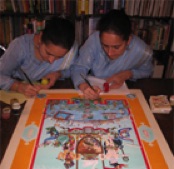BUY / COMMISSION
ORIGINAL ARTWORK
Why we describe our artwork as 'PAST-MODERN'
“Ever since visiting India for the first time in 1980, we have been fascinated by the Indian miniature painting tradition - not least because of the exquisite detail, technical skill and breathtaking level of perfection displayed by this traditional art form. For us it was such a highly appealing style whose rich narrative and symbolic character made it a superb medium of communication that we felt transcended cultural and historical barriers.
But we were disappointed to find that within India’s Contemporary art scene the miniature genre seemed to have been largely neglected in favour of Western role models by Indian artists and Institutions eager to be accepted by the world of Modern Art. Indian miniature paintings were viewed as a historic and outdated tradition. Consequently the tradition has only really survived in the form of mass produced, and often badly executed, copies of conventional scenes churned out for the tourist souvenir market.
Initially, we wanted to revive not only India’s interest in this rejected and undervalued tradition but also bring this rich heritage to the attention of the wider global audience as a way of challenging what we saw as a generally prevailing “West is Best” attitude. And so as teenagers we began to teach ourselves the techniques and style of the miniature by studying reproductions in books and original examples in Museums in the UK.
Later, however, our determination to explore and develop the Indian miniature became even stronger due to the institutionalised prejudice we faced whilst studying for our BA (Hons) degree in art. We were heavily criticised for drawing inspiration from an art form that was both traditional and rooted in Eastern Aesthetics - dismissed by our tutors as "backward", "outdated" and having "no place within Contemporary art". In addition, the work we produced individually was also seen as ‘unacceptable’ because of the similarity of our styles which had developed naturally, as a result of our common sources of inspiration, interests and goals as artists. It seemed that our work represented all the taboos of Contemporary Western art in that it was decorative, figurative, narrative, small scale, non-individualistic and coming from a non-European tradition.
Pressure was put on us by our art tutors to look instead to the ‘Fathers of European Modern Art’ for inspiration and to produce visually distinctive styles from each other that conformed to Western aesthetics - which was ironic considering that many of the western artists presented to us as role models, such as Picasso, Matisse, Van Gogh, Monet and Gauguin, had themselves been influenced by non western art.
Our adherence to the miniature style became a political statement: A way of asserting the right to choose a visual language which was true to our own interests in art and the natural affiliation and pride we felt for our Asian heritage, and challenging the hypocrisy of an Establishment which advocated the western values of ‘self expression’ and ‘individuality’ as the ‘be all and end all’ of Modern Art, yet denied the validity of anything which did not comply with the expectations dictated by its selective, Eurocentric perspective.
It was against this background that our practice of working and exhibiting together (as well as dressing identically) was also formed as a rebellion against a system that judged art according to western values and definitions. Refusing to bend to the dictates of the Art Establishment in order to be accepted, we began to develop an personal style that we define as Past- Modern. One which champions traditional and non-western aesthetics as valid forms of expression within contemporary art and acknowledges the connection that has always existed between past and present,east and west. Not least, the significant impact of traditional and non-European art and culture on western modern art and society.
Whilst asserting the right to define our own cultural and artistic ‘individuality’ in a way that is meaningful and true to whom we are as British Asians, artists and twins our work redresses the need to re-evaluate established cultural definitions, values and role models within the wider context of an evolving global society dominated by western consumer markets and popular culture. This is because, ultimately, our artistic strategy is defined by a sense of
responsibility to look beyond personal issues of identity towards exposing wider cultural prejudices and highlighting other concerns of more global significance.
The desire to make a real difference through our work has fuelled our determination in establishing an international profile that demands acceptance on our own terms – creating a recognised platform for serious debate which has a meaningful impact in challenging pervading social, political and cultural attitudes - particularly those connected to hidden histories of Empire, Colonialism and its legacies.

ABOUT > INSPIRATION